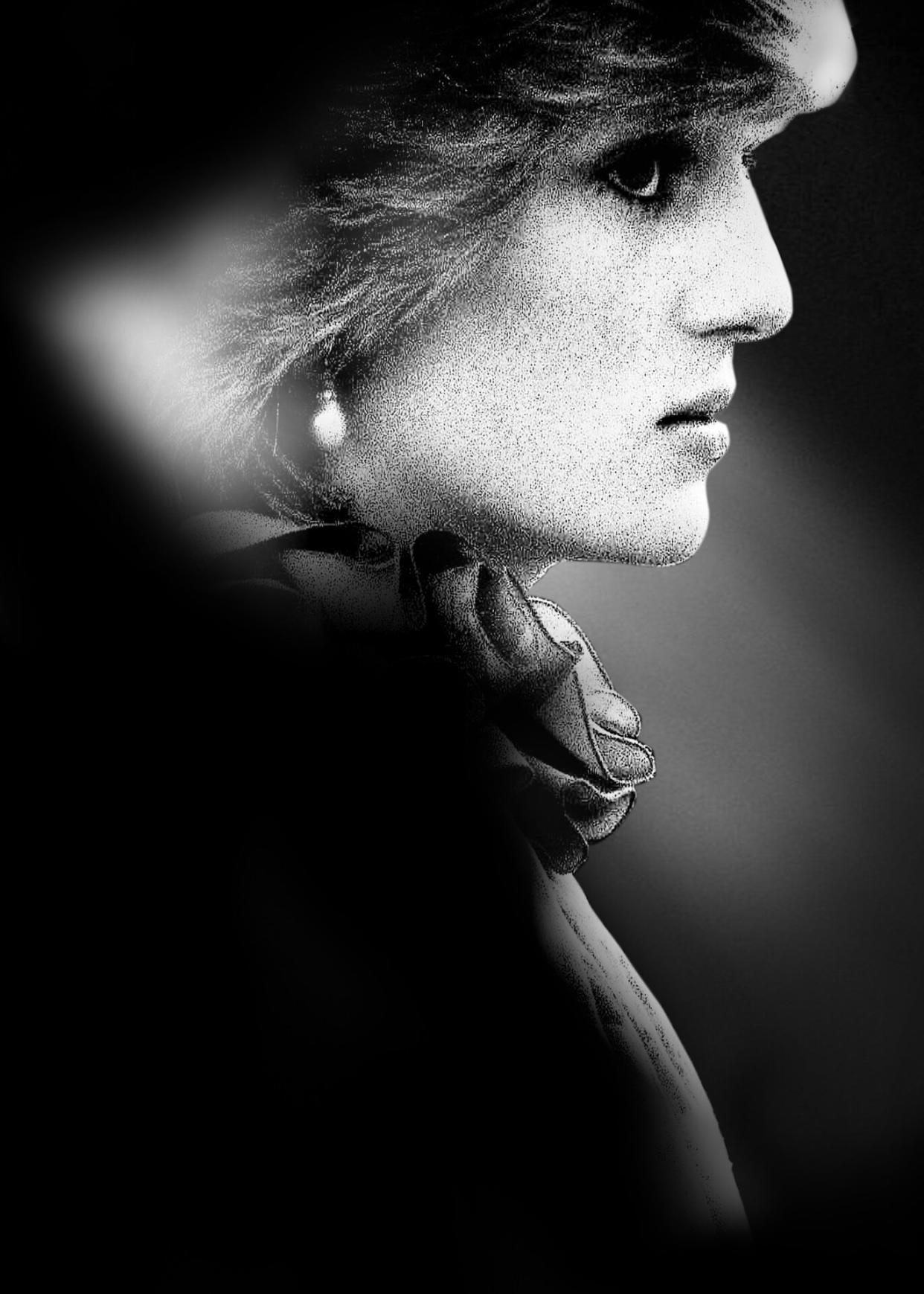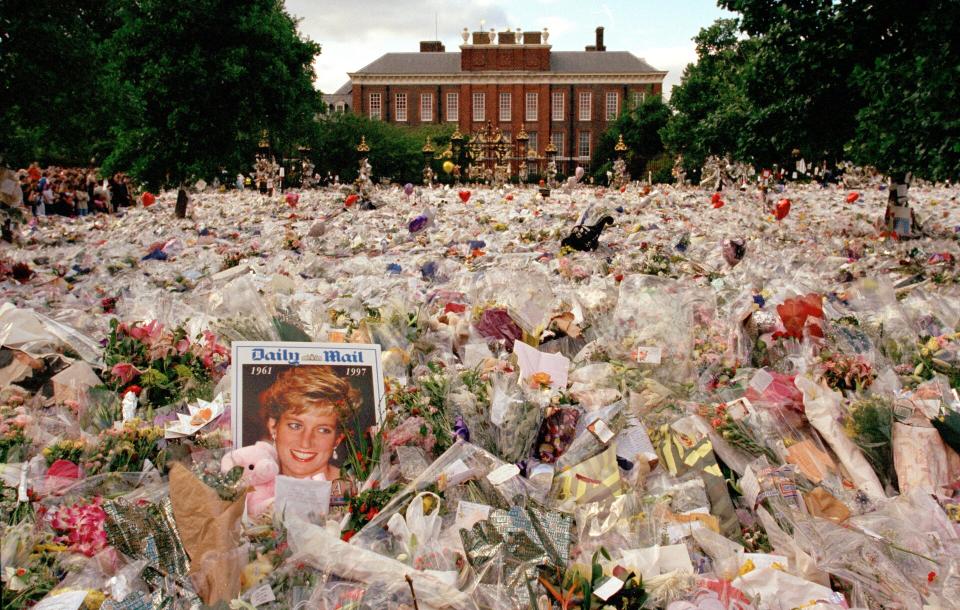The Princess Finds So Many Parallels Between Princess Diana and Meghan Markle

Courtesy HBO
It was the simple word "Mummy" – affectionately handwritten on an envelope placed atop white roses on Princess Diana's casket – that had myself, millions around the globe, and reportedly a 16-year-old Meghan Markle, tearing up during the late royal's televised funeral in 1997. Years later, rewatching such footage in HBO's new documentary, The Princess, felt just as heartbreaking, as did accompanying scenes showing the sea of Brits gathered outside Kensington Palace, the mountains of flowers lovingly left at its gates, and the solemn faces of young Prince Harry and Prince William dutifully greeting grief-stricken locals.
Directed by Ed Perkins, The Princess sets out to present Diana's story through a new lens, by stringing together archival audio and video footage, beginning with her romance with Prince Charles and ending with her 1997 death following a Paris car accident. It covers the highs – from crowds chanting, "It's a boy," following Prince William's birth and cute footage of Diana competing in a sprint race alongside other school moms – to the lows, like the breakdown of her marriage. While there's little new to the 148-minute documentary, the parallels between Diana's struggles and those of modern-day royals hum away in the background, and it's hard not to think of Meghan Markle while observing Diana being shadowed by paparazzi or gracing every magazine cover at newsstands.
Markle also comes to mind when one royal commentator predicted that Diana's engagement would lead to the public interest in her waning and the paparazzi stepping back. It wasn't the case for Diana – nor for Meghan, who eventually fled tabloid-heavy Britain for California life with Prince Harry. In honor of the new documentary's premiere, here are the most powerful moments from the latest film about "The People's Princess."
RELATED: Everything 'The Crown' Got Right (and Wrong) About Princess Diana

Courtesy HBO
"All this telephoto lens business will stop."
"All this telephoto lens business will stop," predicted one royal commentator early on in the film. In retrospect, he couldn't have been more wrong. Following Charles and Diana's engagement, one royal reporter guessed Diana had been through the worst that public attention could throw at her and that interest in her would wane.
Those lenses not only contributed to Diana's death but continue haunting the likes of Megha Markle and Kate Middleton today. "I'm more used to it now," Charles said in an old interview, referring to cameras "poking at you from every corner." Turning to Diana to ask if she was becoming accustomed to the spotlight, she responded with an unconvincing, "Just."
"The biggest thing since Farrah Fawcett."
"The biggest thing since Farrah Fawcett," proclaimed one woman at hair salon in the documentary. Diana rapidly became a style icon, and while she was often described as "sweet," "nice" and "shy," her fashion choices perhaps reflected her inner boldness and desire to stand out and be heard. Take the color red, which she rocked frequently – like the bright red coat she's shown wearing while boarding a plane with Charles to a red outfit at the races, where commentators observed red had become the predominant color.
She also became the biggest hair inspo since Farrah Fawcett, according to one of many British women shown sitting in hair salons copying her 'do – the same way Jennifer Aniston spawned a wave of Friends-inspired cuts in the nineties.
RELATED: The Subtle Way Meghan Markle Paid Tribute to Princess Diana During Her Trip to New York City
"It would have been far easier to have two wives."
As Diana's popularity snowballed, she hogged the limelight, as illustrated during a 1983 visit to Australia. "The couple circled the arena to the kind of reception normally reserved in this age group for popstars," said one reporter. Charles later joked about Diana's popularity in one speech, saying, "I've come to the conclusion that it would have been far easier to have two wives, to have covered both sides of the street. And I could have walked down the middle directing the operation."
One royal observer noted how Diana's warm persona and approachability – qualities often associated with Meghan Markle – further encouraged people to say "Hello." Charles, however, was unhappy about "taking second place."
"Charles doesn't like the fact she's a superstar, and he isn't," one observer said. "There has been a transformation. He has taken a backseat, and it's not enjoyable for him."
"They just don't meet – physically, mentally or emotionally."
The Princess chronicles the cracks that appeared in Diana and Charles's relationship — from Diana's resistance to Charles's attempts to help calm baby William during a family portrait, to his decision to go play polo less than one hour after the couple arrived home with newborn Harry.
"He has always carried on since he got married as if he was a bachelor," said one commentator. When told they "don't appear to hit it off" while skiing, Charles told the interviewer that most married couples have arguments," before Diana jumped in, twice vehemently insisting, "We don't!"
However, any amicable front they presented failed to convince many. "It must be dreadful for the two of them," one royal watcher mused. "They are going around, doing their duties – side-by-side carrying out an engagement – and not even acknowledging the other person's presence. They just don't meet physically, mentally, or emotionally."
"A very healing experience."
"How did this fairytale princess end up in this way?" asked a voiceover, as Diana was shown at India's Taj Mahal in 1992, by which point her struggles with bulimia and marriage troubles had come under greater light through Andrew Morton's book Diana, Her True Story. "In my humble opinion, it is because the institution of the monarchy makes demands on people which simply cannot be satisfied in the world in which we live. When you put a modern person in an ancient institution, they will be destroyed.
"After being shown enjoying a serene moment to herself at the majestic monument, she alluded to her private turmoil, telling the media that the visit had been "a very healing experience."
"It became irretrievably broken down."
News of Charles and Diana's separation in December 1992, further fuelled rumors about the nature of his relationship with Camilla Parker Bowles, who he eventually wed in 2005. "The Prince of Wales, it now appears, didn't marry the first woman he fell in love with – Camilla Parker Bowles – but seems to have felt he had to choose a woman who had not had previous partners and was seen as a very suitable catch," said one commentator.
"And, unfortunately, we no longer live in an era where once you've got married, it's an arranged marriage, and that's that." When asked about Camilla during a 1994 interview with Jonathan Dimbleby, Charles referred to her as a good friend, insisting he had been faithful in his marriage, "until it became irretrievably broken down." Diana later addressed Camilla in a 1995 interview with BBC's Martin Bashir, famously saying, "There were three of us in the marriage."
RELATED: The BBC Is 27 Years Late With Its Apology for That Princess Diana Interview
"I was a problem."
In her BBC interview, Diana also discussed claims that officials were attempting to blacken her name (similarly, Meghan claimed during her 2021 interview with Oprah Winfrey that the Palace was "perpetuating falsehoods about us,") because they were stumped about how to handle her. "I was the separated wife of the Prince of Wales. I was a problem," Diana said in a segment of The Princess. "It had never happened before [so they thought,] 'What do we do with her? She won't go quietly. That's the problem.'"She then added, "I will fight till the end because I have a role to fulfill and two children to bring up. "During an interview with Oprah the following year, Sarah Ferguson was asked why Diana didn't just "behave yourself, do what you're told and play the game."
"I'm afraid for Diana and I. We are like rivers," Fergie replied. "We want to learn more, we want to go around the next corner, we're hungry for more."
"It's the beginning of something."
It's evident in The Princess how much Diana blossomed as she found her freedom and independence and was able to place greater focus on her philanthropic passions. Unlike the meek woman of few words shown in early interviews, she appeared confident and exuberant while embarking on humanitarian endeavors like fighting AIDS and landmines and working alongside the Dalai Lama, Mother Teresa, and Nelson Mandela. She was named Humanitarian of the Year in the U.S, where Hillary Clinton commented, "This is one of the nicest British invasions that The White House has ever had!"
"She has 20/30/40 years of active public life ahead of her," said one royal reporter. "So, people who think of this as the end of something are misunderstanding. It's the beginning of something."
"Sometimes things that seem too good to be true are too good to be true."
Those were the words of American model Kelly Fisher when asked what she would say to Diana if she had the chance. Kelly said she was engaged to Dodi Fayed (who died with Diana in the Paris car accident) when she learned of his involvement with the princess through photos of the pair kissing published in the media.
While some questioned Diana's judgment for becoming involved with the Harrods owner, her PDA was a sign of how madly in love she was, according to one journalist. "This is a woman who suddenly doesn't care – suddenly wants to shout from the rooftops, 'I'm in love, and this is the bloke I'm in love with,'" he said.
"Do not let in daylight upon magic."
Diana's death ignited a heavy debate about the paparazzi and public interest in the royal family. However, some were quick to note how the Palace had decided years prior to "be more populist," so invited cameras in and encouraged examination of themselves. "The royal family has, through misjudgment and ineptitude and a fair degree of stupidity, turned itself into a branch of the entertainment industry," remarked one journalist. "They're doomed to continue. "Another media voice quoted Walter Bagehot, saying, "Do not let in daylight upon magic," before adding, "The monarchy now is in danger of being glared out of existence by too much publicity."

 Yahoo Movies
Yahoo Movies 
